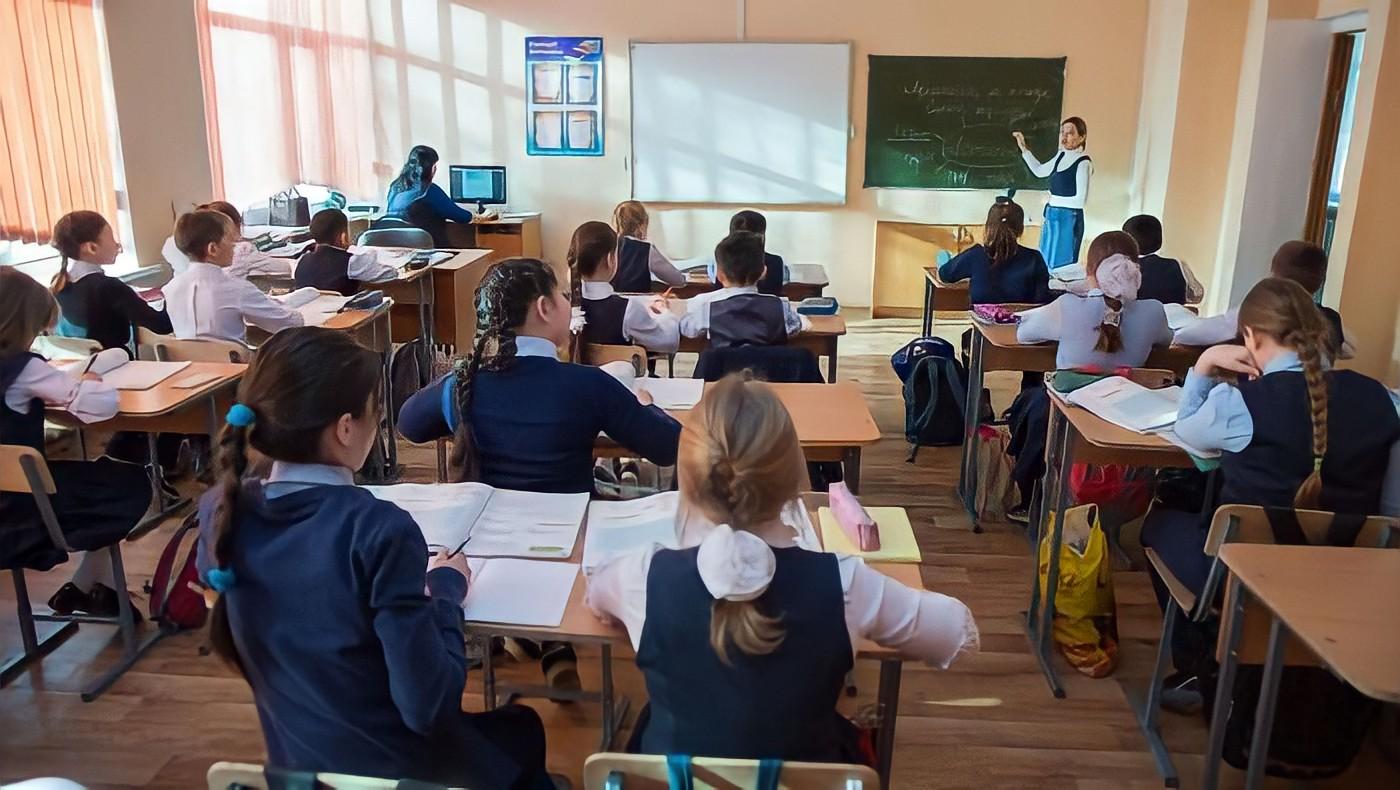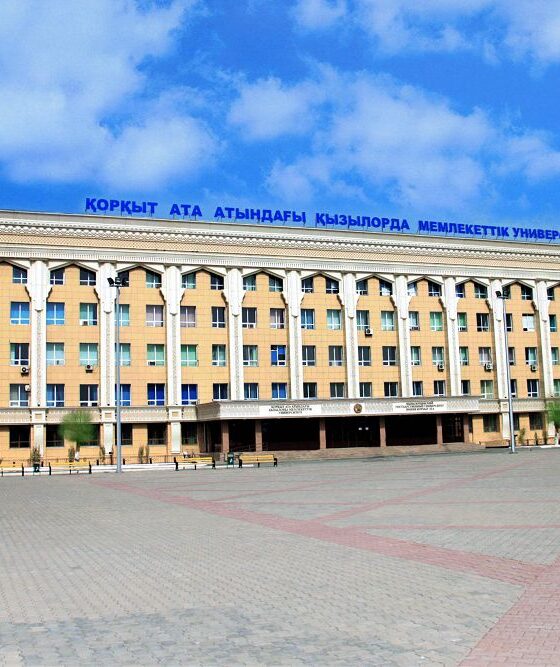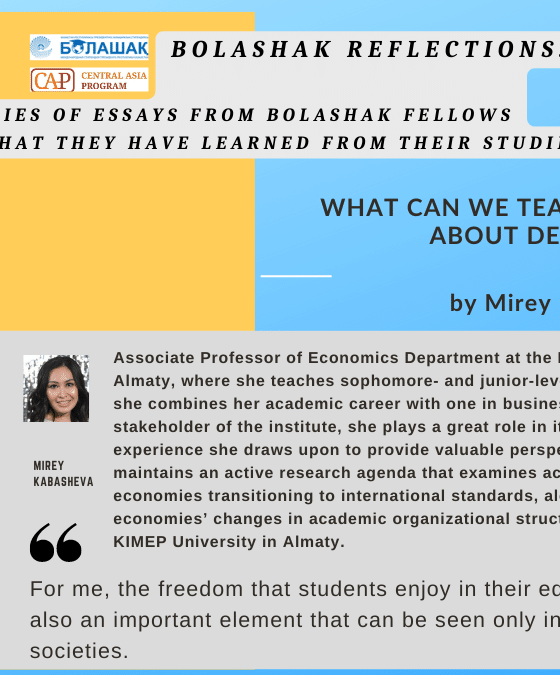By Zhaslan Nurbayev
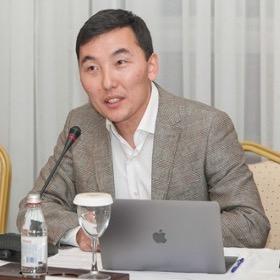 Zhaslan Nurbayev is a PhD / Candidate of Sciences in History and Associate Professor in the Department of Regional Studies of L.N. Gumilev Eurasian National University. In 2014-2015, he completed an internship under the Bolashak Scholarship program at the George Washington University, focusing on “Political Problems of International Relations and Global Development.” Between 2015 and 2019, he participated in expert meetings within the framework of the project “IQ-Club of Russia and Kazakhstan: Development of Expert Dialogue between the Border Regions of the EAEU.” He is a graduate of the Soros Foundation Kazakhstan Public Policy Initiative, where he researched ungraded schools in Kazakhstan. In 2019, he took part in the Central Asian School of Analysts Cabar. Asia, implemented by IWPR, together with the OSCE Academy. His research interests include the history of religions, social policy of the Republic of Kazakhstan, and education reform.
Zhaslan Nurbayev is a PhD / Candidate of Sciences in History and Associate Professor in the Department of Regional Studies of L.N. Gumilev Eurasian National University. In 2014-2015, he completed an internship under the Bolashak Scholarship program at the George Washington University, focusing on “Political Problems of International Relations and Global Development.” Between 2015 and 2019, he participated in expert meetings within the framework of the project “IQ-Club of Russia and Kazakhstan: Development of Expert Dialogue between the Border Regions of the EAEU.” He is a graduate of the Soros Foundation Kazakhstan Public Policy Initiative, where he researched ungraded schools in Kazakhstan. In 2019, he took part in the Central Asian School of Analysts Cabar. Asia, implemented by IWPR, together with the OSCE Academy. His research interests include the history of religions, social policy of the Republic of Kazakhstan, and education reform.
An important principle of the modern education system is equality of educational opportunity. The implementation of this principle is a source of social justice. Therefore, in the Universal Declaration of Human Rights, the right to education is considered fundamental: “education shall be directed to the full development of the human personality and to the strengthening of respect for human rights and fundamental freedoms.”[1]
After Kazakhstan gained independence and cut economic ties with the USSR, not only did industry and agriculture suffer a decline, but so did culture and education. With the economic recovery in the late 1990s and early 2000s, the secondary education system underwent modernization. However, numerous reforms have not led to an improvement in the quality of education. On the contrary, they have produced a gap in educational achievement between rural and urban schools—and that gap appears to be widening, judging by international comparative studies and domestic data.
The international PIAAC study, which assessed the competencies of adult Kazakhstanis aged 16-65, revealed strange results. The functional literacy of young people (25-34 years old) is the same or lower than that of the older generation (55-65 years old). This is although almost 50% of the population aged 25-34 have graduated from university, compared to 27%[2] of citizens aged 55-65. This puts Kazakhstan out of step with the trend among developed countries, which is for each subsequent generation to perform better than the previous one.
The PIACC study shows that access to higher education is increasing. Moreover, equal access to free secondary education is legally mandated, and Kazakhstan ranked among the top ten countries in the IMD-2018 ranking in terms of school enrollment.[3] Significant efforts are being made to improve these indicators. Nevertheless, the disparity in the quality of education is increasing every year.
Accordingly, the research questions are as follows: Why does the principle of equality that is entrenched in Kazakh education not lead to an increase in the quality of education in rural schools? Why is the gap between rural and urban schools only increasing?
The purpose of this study is to analyze the factors that lead to inequality between students of rural and urban schools, as well as to find solutions to the current predicament.
Materials and Methods
Documentary material was drawn from international comparative studies (TALIS, PISA, PIAAC, and ICILS); Kazakhstan’s systems for assessing student achievement (Unified National Testing, UNT); and external assessments of educational achievement (EAEA SE). Important sources include reports and presentations from authorized bodies and research institutes under the Ministry of Education and Science of the Republic of Kazakhstan and analytical studies from international organizations such as the World Bank and the OECD.
Laws and regulations of the Republic of Kazakhstan are considered separate documents. It is worth mentioning here not only documents regulating the field of education—such as the law on education and the program of state development of education and science of the Republic of Kazakhstan—but also intersectoral projects such as “Digital Kazakhstan.”
Various information is provided by the official websites of international organizations (the UN, the World Bank, the OECD, UNICEF, UNESCO); state bodies and educational institutions of Kazakhstan (the websites of the Prime Minister, the Ministry of Education of the Republic of Kazakhstan, the National Testing Center, the National Academy of Education named after I. Altynsarin, regional institutes of advanced training); and the websites of educational information resources (Bilim Media Group, e-Learning).
In addition to analysis of the above documentary sources, field research was conducted via a massive online survey. The survey was conducted from February to April 2021 together with colleagues from the Center for the Development of Small Schools at the National Academy of Education named after I. Altynsarin. Respondents included more than 8,000 teachers and heads of secondary schools from all regions of the country. To accompany the survey, semi-structured interviews were conducted with more than 20 experts in the education sector: researchers, mid-level and senior managers of the secondary education system, heads of regional and city education departments, representatives of the Ministry of Education and Science, and researchers and analysts of research institutes under the Ministry of Education and Science of the Republic of Kazakhstan.
Literature Review
Today, providing high-quality education is one of the main tasks of the state’s social policy, since this directly affects the development of human capital and, consequently, the competitiveness of the country.
Quality of education is interpreted differently depending on the country and time period. If in the 1980 and 1990s the poor academic performance of students in Kazakhstan was explained by personal abilities or weak interest, today the effectiveness of learning depends on pedagogical conditions (the availability of resources, technical means, high-quality teaching staff, etc.)[4]
UNESCO’s international research program “Education For All”[5] identifies four features of education:
- students, their motivation and performance
- processes or proactive activity of teachers
- content, i.e., the quality of the curriculum
- the system, or rational management and allocation of resources
These can be used both to describe and to improve the quality of education. Weakness in one or more of the four areas leads to an imbalance and a consequent decline in the quality of education, a phenomenon that can be observed in Kazakh schools. Aigerim Kopeyeva, an alumna of the Central Asia-Azerbaijan Fellowship Program (GWU), analyzes the achievement gap between students in different regions in great detail.[6]
Another alumnus of this program, Daniyar Kussainov, describes the process of creating a network of Nazarbayev Intellectual Schools (NIS) from 2008, which, according to the author, has produced even more complex differentiations. The trend toward the elitization of secondary education is the main sign of inequality in Kazakhstan’s school system.[7]
Since 2015, the dissemination of the experience of elite niches to all schools of the republic has been part of an effort to update the educational content in Kazakh schools. These new features have been and continue to be very difficult to implement. The particularities and difficulties of this transitional period of “renewal” have been examined in the studies of L.S. Almagambetova, A.A. Kabdirova, and A.S. Kambatyrova, among others.[8]
Teachers play an important role in ensuring the quality of education. According to PISA representative Andreas Schleicher, student outcomes directly depend on the training and qualifications of teachers. In the case of Kazakhstan, the issues of training, retraining, and retention of teachers are discussed by S.A. Irsaliyev and others.[9]
The Ministry of Education and Science of the Republic of Kazakhstan has funded a number of studies looking at the problems of rural schools. In 2015, a project on the topic “Integration of rural resource centers and independent small secondary schools into single educational and information technoparks (a primary school based on a university)” was launched. Some results of this study have been published.[10]
In recent years, the education system, like many other public spheres, has been influenced by the pandemic-related crisis. There are already a number of studies discussing the impact of COVID-19 on the field of education in Kazakhstan, the most popular being those of B. Bokaev, Z. Torebekova, K. Kovyazina, M. Boranbay, S. Beisembayev, and S. Dzhaksylykov.[11]
Despite the large amount of research looking at the quality of education and educational inequality, there are many gaps in the literature when it comes to disparities in educational achievement between students of urban and rural schools.
Schools in Kazakhstan: General Characteristics
An important specificity of Kazakhstan’s education infrastructure is the presence of a large number of rural schools. In the 2020-2021 academic year, 7,384 schools were in operation. Of these, 5,194—that is, more than 70%—were in rural areas.
In the southern regions of Kazakhstan (Turkestan and Almaty territories), full-fledged schools (those with more than 180 schoolchildren) predominate in rural areas. In the northern part of the country, many rural schools are underfilled (i.e. where the number of schoolchildren does not exceed 180). For example, there are 899 schools in the Turkestan region, 88% of which (794 schools) are located in villages and 83% (660 schools) of which are full-fledged schools. There are 468 schools in the Northern Kazakhstan region, including 411 rural schools (88%), of which 362 (77%) are small schools.[12]
Problems with the Quality of Secondary Education
Figure 1. PISA results on reading literacy in the context of the location of the educational organization and cycles, score (2009-2018)
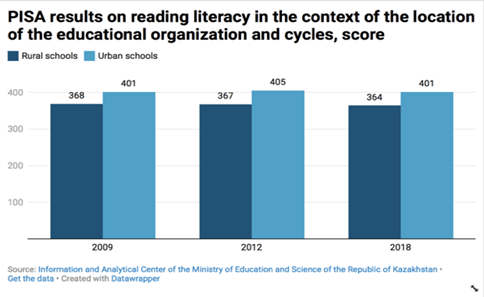
In Kazakhstan today, there is an acute issue with the quality of education in rural schools, which is lower than in urban ones. Proof of this can be found in international comparative studies (TALIS, PISA, ICILS) and national systems for assessing students’ knowledge (UNT, VAUD). Thus, the Program for International Student Assessment recorded the following results for students of rural and urban schools in Kazakhstan in the period from 2009 to 2018 (see Figure 1).
The diagram shows a significant difference (more than 30 points) between students in rural or urban areas. This means that the gap between rural students and their urban peers is approximately one year of education.
The most recent wave of PISA, conducted in 2018, found the following gaps between urban and rural schoolchildren: 31 points in natural science, 22 points in mathematics, and 37 points in reading (see Figure 2).
Figure 2. PISA-2018 results by subject, comparing Kazakhstan to the OECD average
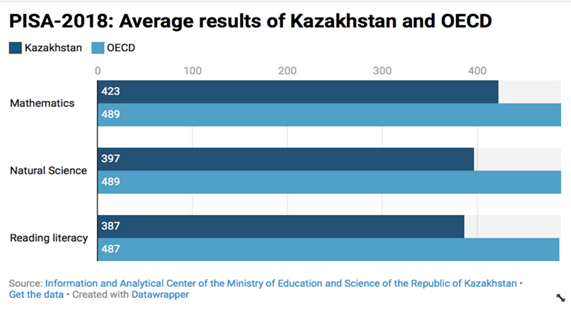
The diagram shows that there is a large (100-point) gap between Kazakh students and schoolchildren from OECD countries in reading literacy. The gap in natural science is almost as wide, at 92 points, while the smallest gap between Kazakh students and their OECD counterparts is in mathematics (66 points).
The International Association for the Evaluation of Educational Achievements (IEA) conducted a study to identify the organizational resilience of schools (an indicator that shows high achievement of schoolchildren with disabilities or from troubled families). The study reveals that there is a critically low number of resilient schools in Kazakhstan, especially in rural areas. It turns out that a child born into a dysfunctional family and who studies at a rural school has almost no chance of achieving success in life. According to the study, the main reason for the small number of resistant schools in Kazakhstan is the weak infrastructure of rural schools, which often have outdated computer equipment and other information and communication technology (ICT).[13]
Low performance when it comes to ICT literacy is visible in the results of the International Computer and Information Literacy Study (ICILS). Out of 14 countries, students from Kazakhstan took the last position.[14] This lack of ICT knowledge has undoubtedly influenced the results of other assessments of education quality, such as the Unified National Testing, a computer-based test that was given for the first time in 2020 (see Figure 3).
Figure 3. Results of the Unified National Testing for 2020 in the context of rural and urban schools
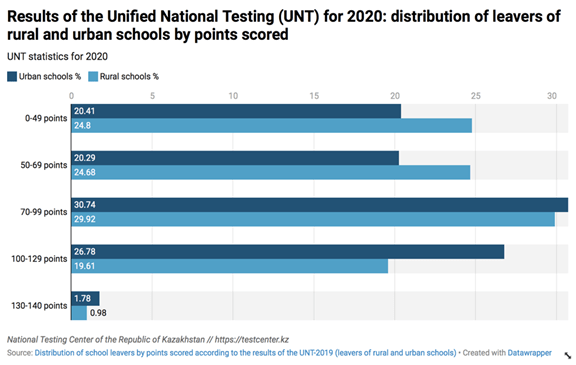
In 2020, students had to receive a score of at least 70 points to go on to study in pedagogical specialties. Almost half of graduates of rural schools did not meet this threshold. Only 20% of graduates of rural schools and about 30% of graduates of urban schools scored more than 100 points.[15] In 2021, the threshold score for pedagogical specialties has been increased to 75 points.
An external assessment of academic achievements, the EAEA SE, shows that the gap between rural and urban schoolchildren has been increasing every year (see Figure 4). Whereas in 2012 rural students lagged behind their urban peers by 1.82 points, in 2018 the disparity was 7.08 points.[16]
As such, it is clear that there is a growing disparity between rural and urban schools in terms of academic outcomes. A similar phenomenon can also be observed in other countries. What factors of inequality are specific for Kazakhstan?
Figure 4. Academic performance of rural and urban students according to the results of the EAEA SE (2012-2018)
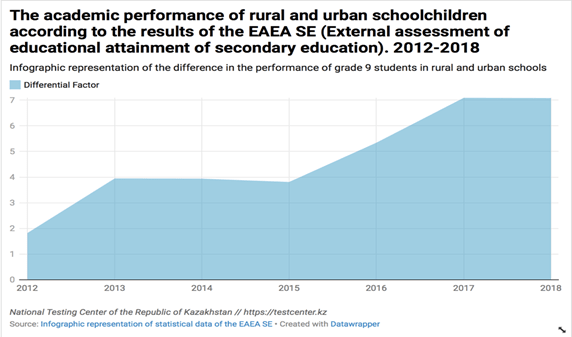
First, the official statistics of educational facilities are at odds with the real state of affairs. Оften, the school authorities falsify data in order to improve the rating of their school. The pursuit of ratings affects the material and technical support of schools.
Second, the large number of school reforms that are being carried out in Kazakhstan are being developed by different departments and state organizations, with the result that they are often contradictory. In addition, there is no analysis of whether the reforms have been implemented and whether they are effective.
In addition, teachers often suffer from a large workload and unpaid additional work.
Analysis of Factors of Inequality between Rural and Urban Schools
Material and Technical Foundation
One of the important and fundamental factors affecting the quality of education is schools’ material and technical foundation. International studies, including PISA-2012, highlight the relationship between students’ educational achievements and the material equipment of schools.
Today, there is a large gap between rural and urban schools in terms of their material and technical foundation.
In the 2020-2021 academic year, 36 secondary schools were in a state of disrepair, almost all of which were located in rural areas. 509 schools (7.3%) had toilets outside rather than in the school building. 474 of these outdoor toilets were in rural schools.[17] Most of the schools that need repairs are located in the Almaty territory; indeed, schools that need repairs account for 20% of all schools in the region.[18] This is due to old construction, weak design and planning work by the regional education department, and ineffective fund distribution.
According to “Statistics of the Education System of the Republic of Kazakhstan—2020,” gyms are located in adapted buildings in 10.2% of schools, while sports complexes are entirely absent from 25% of schools. About 15% of rural schools lack libraries, as well as cafeterias and buffets. In 1,497 localities, there are no schools, with the result that 25,352 students have to be transported elsewhere: 90% are taken to the nearest school, 9% study and live in boarding schools, and less than 1% move in with relatives to access education.[19]
In in-depth interviews, experts in the field of education likewise pointed to the level of material and technical equipment of schools as one of the most important factors affecting education quality.
The first set of interview questions was devoted to cause-and-effect relationships and asked: What factors influence the improvement of education quality in rural schools? Please provide the 3 most important reasons why, in your opinion, the existing gap between rural and urban schools formed and continues to increase.
Almost all of the experts agreed that the main reasons for the current state of rural education are (see Figure 5):
- financing and logistical support;
- quantity and quality of teachers; and
- issues with management of the educational sphere.
Interviewees’ answers included the following statements:
E1: “Infrastructure is an important part of any process, including educational ones. Now we can observe a large gap in the material and technical facilities of rural and urban schools.”
Е7: “There are three significant factors that have a negative impact on the quality of educational services in rural schools: the first is outdated infrastructure, i.e., outdated buildings, buildings that do not have gyms, studios, libraries, etc. The second is the quality of teaching staff working in rural schools. The third factor is the exodus of the population and the reduction of villages and the rural population, including the teachers.”
Figure 5. Reasons for the increasing disparity between rural and urban schools (based on a survey of experts
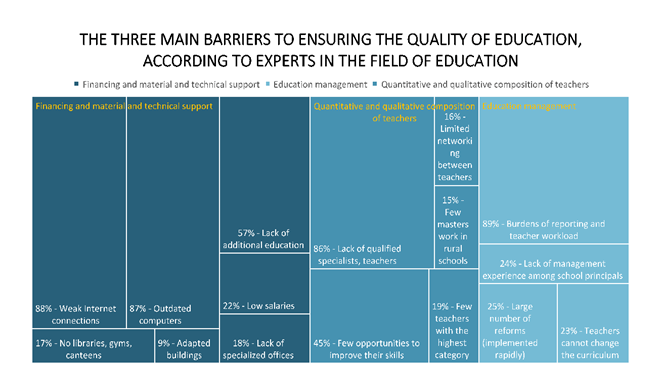
Е18: “The economic component. This relates primarily to financing. The mode of funding should change, since we determine it on the basis of the number of children, the number of hours, the teaching rate, etc. Here we need an approach where even a class with three students has teachers and funding is provided. Only in this way will we address the issue of a shortage of specialists and professionals.”
The most urgent issues related to material and technical equipment in rural schools are outdated computers and the lack of high-speed internet.
The policy of digitalization and equipping schools with computers and other interactive equipment in Kazakhstan is being carried out quite actively. Whereas in 2005 there were 41 students per computer (36 students per computer in rural areas),[20] by 2015 this figure had already improved to 10 students per computer.[21] Today, there are 6 schoolchildren per computer.
An interesting situation has developed in rural schools, where there are now four students per computer (i.e., better than the average for all schools). However, the proportion of computers in rural schools that need to be replaced is also much higher: in certain regions, it reaches 80%, compared to the national average of 35%.[22]
This prompted the following question that was posed to experts: “Why, according to official statistics, are the issues of information and communication technologies not reflected in relation to the material and technical framework of rural schools?” The answer was quite predictable:
E5: “Reporting is one thing—we are all aware of how regions report. To prevent their schools from appearing as ‘laggards,’ they point to technology that cannot actually be used in the educational process. Therefore, no one talks about the quality of such equipment, only indicators of quantity. Maybe it does not fit the technical characteristics for use at all, but nevertheless, they are indicated for the sake of reporting.”
A similar situation can be seen with regard to access to broadband internet. Kazakhstan’s schools are working to expand access to the internet. For example, in 2005, 75% of schools had internet in the average (at the same time, 70% of rural schools were equipped with the internet connection) whereas by 2010 these figures were 98% and 97%, respectively.[23]
Today, 100% of schools in the republic have internet access, of which 4,020 schools, or 55%, have internet speeds over 4 Mbit/s. These are mostly urban schools. The situation in rural schools is much more complicated: 69% of rural schools (1,952) have internet at speeds below 4 Mbit/s.[24]
The forced transition to distance education in 2020 due to the COVID-19 pandemic demonstrated the poor condition of technical equipment and the weakness of the internet both in rural schools and throughout the country.
The interviewed experts discussed the problem of the quality of internet connections at length:
E2: “The pandemic clearly showed a large gap in the material and technical capacity of rural and urban schools. Starting from the availability of digital resources and ending with internet access, there were big problems.”
E15: “Regarding the Internet, I myself participated in PISA-2018 and traveled around the region. I was assigned to one district. To carry out the assessment, it was necessary to go to the director’s office, where the internet was also weak with a minimum speed, or to the akimat [local executive authorities], and transfer all the data. There were problems both with the internet and with the quality of laptops. We asked them to prepare laptops for testing, but we needed to install a specific program, and the computers and laptops provided were not compatible with this program. The computer lab was outdated and it came to the point that we drove around the village at night and looked for suitable laptops among local residents that could support the program, brought our personal laptops, and borrowed [laptops] from neighboring villages in the district. In short, there were a lot of inconveniences.”
E9: “Rural schools are significantly inferior in terms of material and technical equipment, the lack of resources, and the fact that broadband internet is practically absent there. Previously, there was an initiative, “Bilim-books,” that provided good materials to the republic’s schools. However, the technology is now rapidly becoming obsolete. The same interactive whiteboards and computers will become unusable after a certain time. From here, it is necessary to provide not only equipment, but content, such as educational materials and methodological developments. These should be in every school.”
The international study TALIS-2018 revealed several impediments to the development of quality education in Kazakh schools. School principals who participated in this study identified three main barriers: lack of equipment or its non-compliance with digital equipment standards, lack of access to the internet or limited internet, and inadequate school infrastructure.[25]
Thus, the main difficulties in improving the quality of education in rural schools are related to material and technical provision, specifically the quality of the internet and computer lab. Indeed, these are the reasons indicated by the participants in the mass online survey (see Figure 6).
Figure 6. Reasons for the increasing gap between rural and urban schools (based on a mass online survey)
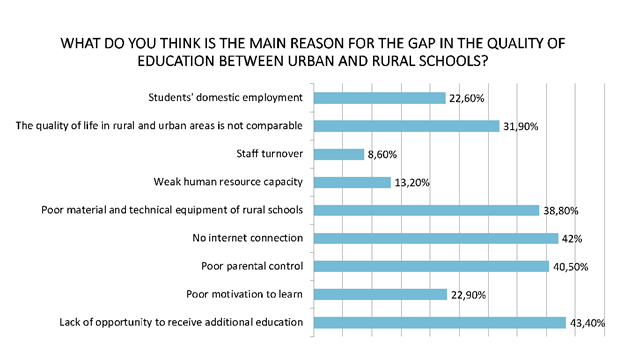
In addition to the material and technical foundation, the respondents identify the following important factors that limit the educational achievements of rural students: a lack of opportunities to organize additional education in rural areas, weak parental control over student progress, low quality of life in rural areas, and high employment of children in farming.
We often hear from experts that in order to raise the quality of education in rural schools, it is necessary to raise the quality of life in rural villages:
E14: “The policy of shrinking villages that is being conducted in the country is not correct. It is necessary to preserve schools, it is necessary to give families the opportunity to live and work in villages. This is the only way these settlements, the places they have settled, will be preserved, where there is at least some infrastructure and there is already some production, where there are opportunities to preserve this settlement.”
E5: “The closure of rural schools is absolutely wrong! Two aspects—socio-economic support of villages and infrastructural support for schools—will allow us to save lives in the villages. The countries that have provided this kind of support in similar territories and schools have succeeded with these strategies.”
E3: “We need to understand that the preservation of villages is necessary. We are witnessing the growth of the country’s population. If infrastructure has remained in a particular locality since the Soviet era, there is farming and potentially industrial production. Such villages need to be preserved. A school is where people live, it’s a place where you can live. It is much easier to restore than to create everything again.”
E19: “A small school does not correlate with poor quality. On the contrary, it has the potential for development and growth of the quality of education. The crowded classes of cities and megacities confirm this thesis. Thus, a comprehensive approach to the development of village and rural schools is needed.”
E11: “We need support from the state for the development of rural areas. These are social programs that should be strengthened as much as possible […] We need to preserve schools—they are the center-forming objects of any society and settlement, regardless of scale.”
Qualifications of Teachers in Small Schools
It is well known that the most influential factor determining the academic success of students is the professionalism of teachers. The teacher transmits knowledge and instills skills, abilities, and competencies in students. No wonder, then, that the English scientist Lawrence Stenhouse noted that only teachers who have learned the world of the school from the inside will be able to change it.[26]
In 2020, 329,623 teachers were employed in Kazakhstan, of whom 59.3%—or 195,306 teachers—worked in rural areas. Among teachers in rural schools, only 2,159 (1.2% of rural teachers) have master’s degrees, one-third the number of urban teachers who have such qualifications. Other than that, the educational level of teachers in rural and urban schools is almost the same (see Figure 7).
Figure 7. Education levels of teachers in rural and urban schools
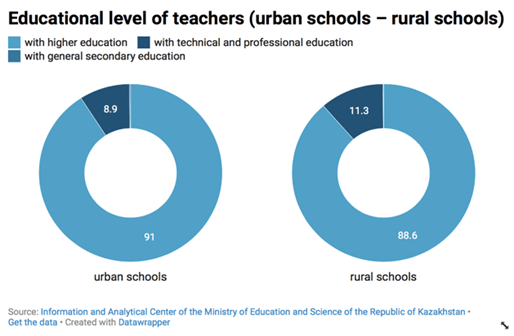
Figure 8. The level of qualification of teachers in rural and urban schools.
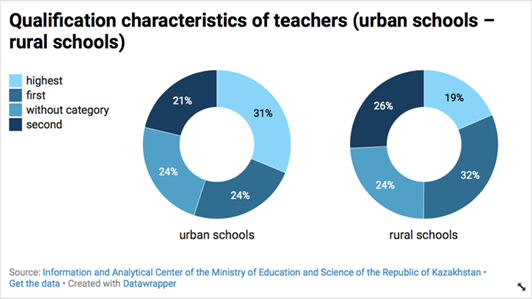
However, rural teachers tend to have been less successful in their studies than their urban counterparts. For example, the share of teachers with the highest category is 1.6 times less in rural schools (in urban schools 31%, in rural schools 19%). Conversely, the proportion of teachers with the first category and without categories is 5-6% higher in rural schools (teachers with the first category comprise 24% of those in urban and 32% of those in rural schools, while teachers without categories comprise 21% and 26% of the total, respectively).[27]
Experts believe these low scores are related to the issue of training and retraining teaching staff:
E4: “There is a big issue with the training and professional development of teachers. Today, about 40% of teachers in the region have a graduation diploma from a remote university program; in a rural small school this indicator is more than 60% (out of 2,570 teachers, 1,605 received a pedagogical education remotely).”
E20: “In rural schools, a certain phenomenon exists called ‘professional or pedagogical loneliness.’ If in large urban schools 5-6 or more teachers teach one subject and there is a competitive environment that favors development, then in rural schools, unfortunately, this is very rare. There is no accumulation and exchange of opinions and no interactive professional collaboration, which leads to rapid professional burnout of teachers. This reality is the result of a small cohort of rural schools and a small number of hours.”
The results of the international study TALIS-2018 revealed that teachers in Kazakhstan are busier than their colleagues from OECD countries. The average working week of Kazakh primary school teachers was 48.8 hours, of which only 15 hours were occupied by teaching. The rest of the time was spent compiling numerous reports and conducting extracurricular activities with schoolchildren. On average, in OECD countries, a teacher’s working week is 38.8 hours, of which 20 hours are occupied by teaching. Thus, Kazakh teachers spend 5 hours less actually teaching, even though they work 10 hours more.[28]
The final block of questions on the mass online survey was devoted to recommendations. Most of all, respondents were concerned about the excessive reporting requirements, teachers’ workloads, the historically poor quality of the internet, the endless nature of reforms, and salary increases. These concerns produced the following recommendations (see Figure 9):
The interviewed experts made both similar and different recommendations for reducing the gap between rural and urban schools, as well as for reducing the shortage of teaching staff in rural schools:
E10: “The current problem of a lack of teaching staff can be solved by attracting 3rd– and 4th-year students-interns to rural schools. The intern will gain experience, earn money, and address the deficit of teachers at the same time. In addition, they will enter the specialty and will see all the problems of a rural school from the perspective of a student. Today, teaching practices are short-term; their duration generally does not exceed 2 months. They need to be made long-term at the senior levels—at least six months or one year.”
Figure 9. Proposals to reduce the gap between rural and urban schools (based on a mass online survey)
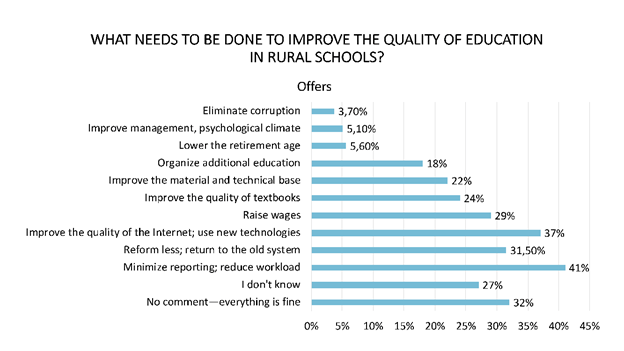
Equally important is the issue of skillful management in the field of education, which was actively discussed by the experts:
E9: “Today we need a central manager who has an accurate strategic vision of the school’s development and a conceptual solution to the educational and methodological issues of the school. If we are currently training dual specialists—for example, physicists and computer scientists, chemists and biologists—this is not enough. It is necessary to train managers who conceptually understand the problems of rural schools and can formulate solutions to these problems. If such managers are supported fairly financially, then good specialists will go to the village and they will be able to raise the quality of education.”
E21: “Management, strategic vision, and leadership are important things for a contemporary school. Many school principals and headteachers have outdated approaches to management. […] The board of trustees will celebrate the 14th anniversary of their existence this year, despite the fact that I have never heard anything about the effectiveness of their work. They are a formalized institution, when in fact it should be a single union of top management and boards of trustees that helps develop the organization of education. Therefore, it seems to me that this is a systemic issue throughout the whole country and advanced training courses for the board of trustees in the field of leadership, strategic management, and administration can help here.”
E20: “In order to improve management in education, it is necessary not only to take advanced training courses, but also to have unions, organizations of teachers, network interaction between them, and a rotation of school principals. On average, the tenure of a director in Kazakhstan is quite long compared to European countries. The main term is 5 years, but directors typically remain for 10 or 20 years with the same approaches in management. However, now the situation is improving, especially in universities and schools in the capital.”
A very important proposal from the experts was the scientific support of all state programs and projects:
E13: “We have a large number of universities that could take part in the scientific support of programs and projects. Regional universities could investigate the problems of rural schools in the region, which have their own characteristics and specificities.”
Е16: “It is necessary to include teachers and students of rural schools in these projects and look for ways out of the current situation together. It would be interesting for everyone, as university scientists would examine scientific issues and children and teachers of rural schools would take part in the practical part, which would give the results of the study a more positive effect.”
Е21: “It would be possible to carry out scientific research through program-targeted funding of universities. The most important goal of such projects is to involve all participants of the educational process in research activities. Tomorrow, this student will go further and master even more complex tasks. This teacher can think not in terms of only one small school, but go beyond his locality and be not just a teacher, but a real teacher-researcher.”
Conclusion
In Kazakhstan, the secondary education system is undergoing comprehensive reform. However, the state’s measures to eliminate inequality in education have led to even greater differentiation between urban and rural schools. Improving the quality of education in rural schools depends not only on the principle of equality, but also on the principle of justice. To this end, we propose to develop and implement special programs for rural schools:
1. The concept of development of rural schools in Kazakhstan;
2. A special program for financing rural schools;
3. A program for the digitalization of educational organizations (treating rural schools
separately).
To improve the quality of education in rural schools and thereby reduce inequality between rural and urban schools, the following recommendations are proposed:
1. Investment reforms. The financing of the education sector should be perceived as an investment in a better future. It is impossible to get instant income from this sector, but it has the potential to offer significant long-term dividends.
- Program-targeted financing of research projects looking at the problems in rural education. It is necessary to analyze all the previous reforms and to conduct localized studies of the problems facing schools in each region.
- A special allowance for teachers working in combined classes. One of the difficulties of a rural school is combined classes, e.g., when students in third and fourth grade study together. Such teachers need additional payment.
- Mandatory additional payments to teachers for additional work.
2. Smart-reforms. New technologies can help to overcome inequality in education. We therefore propose:
- The creation of digital educational resources through an initiative of teachers and students. Previously, these resources were created by individual organizations and were accompanied by corruption scandals.
- The organization of regional workshops for the repair and maintenance of computers. This will make it possible to fix old computers and distribute them to families in need with school-age children.
- The creation of a national TV channel with programs for rural schoolchildren. Digital, TV, and other products for remote education need to be further developed and used to improve the quality of rural schools.
3. Comprehensive reforms. Only a systematic and integrated approach will help solve the issues related to rural education.
- It is impossible to solve the problems in rural education without solving the problems of villages and rural territories. It is crucial to restore the infrastructure of villages and improve production and agriculture.
- Joint activities of rural schools, universities, local self-government bodies, and other interested parties, e.g., internships for students of pedagogical universities in rural schools.
- Reduction of the threshold score for applicants from rural schools who wish to enter pedagogical specialties. If we do not consider this now, then in the future we may experience an even greater shortage of personnel in rural schools.
[1] Universal Declaration of Human Rights of December 10, 1948, Art. 26.
[2] PIAAC, “Kazakhstan. Kliuchevye rezultaty,” http://piaac.kz/mobile/PIAAC_CN_rus.pdf.
[3]IMD, “IMD World Competitiveness Yearbook 2018,” https://www.imd.org/research- knowledge/books/world-competitiveness-yearbook-2018/.
[4] E.V. Piskunova, Podgotovka uchitelia k obespecheniiu sovremennogo kachestva obrazovaniia dlia vsekh: opyt Rossii: Rekomendatsii po rezul’tatam nauchnykh issledovanii, ed. G.A. Bordovskii (St. Petersburg: Herzen, 2007), 12-13.
[5] UNESCO, “World Education Report: Education for All,” 2000, https://en.unesco.org/gem-report/report-education-all-efa.
[6] Aigerim Kopeyeva, “Factors behind Regional Inequality in Education in Kazakhstan,” CAP Paper 224, July 2019, https://www.centralasiaprogram.org/archives/13087.
[7] Daniyar Kussainov, “Inequality in Secondary Education and Kazakhstan’s Risk of Becoming a Fragmented Society,” CAP Paper 194, July 2017, https://www.centralasiaprogram.org/archives/10839.
[8] L.S. Al’magambetova and A.A. Kabdirova, “Monitoring trudnostei pedagogov v ponimanii soderzhaniia, metodov i form organizatsii uchebnogo protsessa v usloviiakh obnovleniia soderzhaniia obrazovaniia Respubliki Kazakhstan,” Obrazovatel’nyi protsess 2 (2017): 12-17; Kamila Koviazina, “Reforma srednego obrazovaniia: v chem effektivnost’, brat?” Ekonomist.kz, 2019, https://ekonomist.kz/kovyazina/reforma-shkolnogo-obrazovaniya/; A.S. Kambatyrova, “Novoye soderzhanie nachal’nogo obrazovaniia v Kazakhstane: aprobatsiia i opyt,” Vestnik KazNU 3 (2016): 20-32.
[9] S.A. Irsaliyev, M.B. Kamzoldayev, D.N. Tashibaeva, and A.T. Kopeyeva, eds., Analiticheskii otchet ‘Uchitelia Kazakhstana: pochemu molodye liudi vybiraiut etu professiiu i chto ikh motiviruet ostavat’sia v nei?’ (Astana: Beles, 2019).
[10] O.A. Shunkeeva, B.K. Al’murzaeva, D.G. Naurzalina, A.A. Zhaitapova, K.G. Satybaldina, and Sh.I. Tulegenova, “Integratsiia sel’skikh resursnykh tsentrov i samostoiatel’nykh MKSh v edinyi obrazovatel’no-informatsionnyi tekhnopark (opornaia bazovaia shkola na baze vuza)” Izvestiia Natsional’noi akademii nauk Respubliki Kazakhstan 3 (301) (2015): 264-270; “Sovremennaia malokomplektnaia shkola Kazakhstana—tsentr sotsiokul’turnogo razvitiia i informatsionnogo prostranstva sela,” Fundamental’nye issledovaniia 2 (14) (2015): 3175-3179.
[11] B. Bokayev and Z. Torebekova, “Otsenka vovlechennosti roditelei v uchebnyi protsess v period Covid-19: analiz sotsiologicheskogo oprosa (keis Kazakhstana),” Kazakhstan-Spektr 2 (94) (2020): 97-106; K. Koviazina, M. Boranbai, and S. Beisembaev, Distantsionnoe obrazovanie v Kazakhstan glazami uchitelei i ekspertov: vyzovy i vozmozhnosti (Nur-Sultan, 2021); S. Dzhaksylykov, Dnevniki distantsionnogo obucheniia: kakoi byla ‘distantsionnaia’ shkol’naia chetvert’ glazami uchenikov i rodietelei (Nur-Sultan, 2021).
[12] Natsional’nyi sbornik ‘Statistika sistemy obrazovaniia Respubliki Kazakhstan’ (Nur-Sultan: AO Informatsionno-analiticheskii tsentr, 2021), 72, 74.
[13] Kerstin Drossel, Birgit Eickelmann, and Mario Vennemann, “Schools Overcoming the Digital Divide: In Depth Analyses towards Organizational Resilience in the Computer and Information Literacy Domain,” Large-Scale Assessments in Education 8 (2020):https://doi.org/10.1186/s40536-020-00087-w.
[14] “Results of the International Computer and Information Literacy Study (ICILS) 2018,” https://www.iea.nl/sites/default/files/201911/ICILS%202018%20infographics%20final%20release%205%2011%2019.pdf; “IEA International Computer and Information Literacy Study 2018 International Report,” https://www.iea.nl/sites/default/files/2019-11/ICILS%202019%20Digital%20final%2004112019.pdf.
[15] National Testing Center, “Staticheskie dannye ENT za 2020 god,” http://testcenter.kz/ru/stats/statisticheskie-dannye-ent/?arrFilter_pf%5BYEAR%5D=111&set_filter=Көрсету&set_filter=Y.
[16] National Testing Center, “Infograficheskoe predstavlenie staticheskikh dannyk VOUD SO,” https://testcenter.kz/ru/stats/voud-so/2018/.
[17] Natsional’nyi sbornik ‘Statistika sistemy obrazovaniia Respubliki Kazakhstan,’ 2021, 177, 183.
[18] Natsional’nyi sbornik ‘Statistika sistemy obrazovaniia Respubliki Kazakhstan’ (Astana: AO Informatsionno-analiticheskii tsentr, 2019), 205.
[19] Natsional’nyi sbornik ‘Statistika sistemy obrazovaniia Respubliki Kazakhstan (Astana: AO Informatsionno-analiticheskii tsentr, 2020), 173, 176.
[20] State Program for the Development of Education in the Republic of Kazakhstan in 2011-2020.
[21] Natsional’nyi sbornik ‘Statistika sistemy obrazovaniia Respubliki Kazakhstan (Astana: AO Informatsionno-analiticheskii tsentr, 2016), 180.
[22] Zh.E. Nurbayev, “Neravenstvo v sisteme srednego obrazovaniia: analiz politiki reformirovaniia malokoplektnykh shkol Respubliki Kazakhstan” (2021), 24 // https://www.soros.kz/wp-content/uploads/2021/02/Неравенство-в-системе-СО-_-рус.pdf
[23] Gosudarstvennaya programma razvitiya obrazovaniya Respubliki Kazahstan na 2011-2020 gg. // https://adilet.zan.kz/rus/docs/U1000001118
[24] Natsional’nyi sbornik ‘Statistika sistemy obrazovaniia Respubliki Kazakhstan, 2020, 180, 182.
[25] R. Syzdykbayeva, Mezhdunarodnoe issledovanie prepodavaniia i obucheniia TALIS-2018: pervye rezul’taty Kazakhstana. Natsionalnyi ochet, pervyi tom (Nur-Sultan: MON RK, AO “Informatsionno-analiticheskii tsentr,” 2019), 23.
[26] Irsaliev et al., Analiticheskii otchet, 8.
[27] Natsional’nyi sbornik ‘Statistika sistemy obrazovaniia Respubliki Kazakhstan, 2020, 106, 108, 109, 119, 195.
[28] “Results,” TALIS 2018, https://read.oecd-ilibrary.org/education/talis-2018-results-volume-i_1d0bc92a-en#page31.

